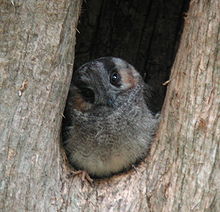Baumschwalm
| Baumschwalm | ||||||||
|---|---|---|---|---|---|---|---|---|

Baumschwalm |
||||||||
| Systematics | ||||||||
|
||||||||
| Scientific name | ||||||||
| Aegotheles cristatus | ||||||||
| ( Shaw , 1790) |
The tree swallow ( Aegotheles cristatus ) is a nocturnal bird from the cave swallow family (Aegotheles). It is found throughout Australia and southern New Guinea in open woodlands. It is a small to medium-sized cavern with a gray upper body and a white striped chest. In addition, it is the most common species of the cave swallow and the most famous representative of this secretive family. Because of its owl-like appearance, it is also called " Moth owl " or " Fairy owl " in Australia .
It is common in Australia and, despite a decline due to competition from introduced species, its population is not endangered. The IUCN classifies the tree swallow population as ![]() (= least concern - not endangered). There are two subspecies in the range of the tree swallow.
(= least concern - not endangered). There are two subspecies in the range of the tree swallow.
description
The tree swallow reaches a body length of 21 to 25 centimeters. The wingspan is 36 to 44 centimeters. The tail is 9.4 to 12.2 centimeters in length. The weight is between 42 and 52 grams. The females are slightly larger than the males. The wings are pointed and the feet are unusually large for a member of this family. If it flies up during the day, the flight is quick and direct. At night, on the other hand, the flight is fluttering and moth-like, which has led to the common English name "moth owl". Despite this fluttering flight, it is a very skillful bird that catches part of its prey in flight. If, on the other hand, it pursues its prey on the ground, its fast run and tail wagging are reminiscent of the movements of wagtails .
Basically, the plumage of the tree swallow is slightly different depending on the distribution area. Tree swallows that live in Tasmania have the darkest plumage. The body plumage is gray with fine darker horizontal stripes, in some individuals the plumage is also reddish-brown-gray or reddish-brown overlaid. Basically, it is the females who have such a plumage tone.
The head is gray with a black stripe on the top and one above each eye. A pale or red-brown stripe runs down the nape of the neck. The tail and wings are cross-banded dark. There are some brush springs above the beak. The beak is black-gray, the eyes dark brown, the feet are flesh-colored.
Young birds resemble adult birds in their plumage, but the black markings on their heads are still indistinct.
Distribution area and habitat
The tree swallow occurs on the entire Australian continent, on Tasmania and on smaller islands off the coast. It is also common in southern New Guinea.
The tree swallow is adaptable and occurs in light forests, mangrove swamps and grasslands as well as in denser forest areas. It prefers eucalyptus and acacia forests, but also occurs on the edge of mangrove forests and can be observed along roads and roadsides in rainforests. He is a resident bird and the pairs each occupy a territory.
Way of life
The tree swallow is nocturnal. During the day it usually rests individually in caves or crevices.
The tree swallow mainly eats insects that it catches while waiting. Occasionally it catches insects in flight. It breeds in caves and is mostly dependent on tree hollows. These are laid out with leaves by both parent birds. They prefer to use eucalyptus leaves for this. This may help keep the number of parasites down.
The breeding season falls between August and December. The clutch consists of three to four eggs. Only the female parent bird breeds. The breeding season is just under a month. The nestlings are cared for by both parent birds. The young nestlings are very active and climb in the nest over their parent birds.
literature
- Handbook of the Birds of the World , Volume Five, Barn-owls to Hummingbirds; de Hoyo, Elliot and Sargatal , ISBN 84-87334-20-2 .
- Ronald Strahan: Cuckoos, Nightbirds & Kingfishers of Australia . Angus & Robertson, Sydney 1994, ISBN 0-207-18522-0 .
Web links
- Aegotheles cristatus cristatus Australian Faunal Directory
- Aegotheles cristatus inthe IUCN Red List of Threatened Species 2016.1. Posted by: BirdLife International, 2016. Retrieved December 17, 2016.
Single receipts
- ^ A b Strahan: Cuckoos, Nightbirds & Kingfishers of Australia . P. 100.
- ↑ Aegotheles cristatus in the IUCN Red List of Threatened Species 2016.1. Posted by: BirdLife International, 2016. Retrieved December 17, 2016.
- ^ A b Strahan: Cuckoos, Nightbirds & Kingfishers of Australia . P. 102.
- ^ A b Strahan: Cuckoos, Nightbirds & Kingfishers of Australia . P. 101.

